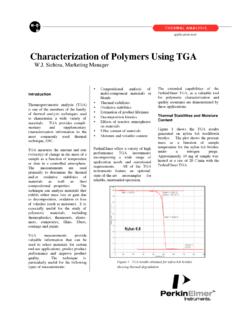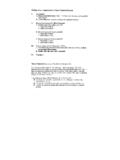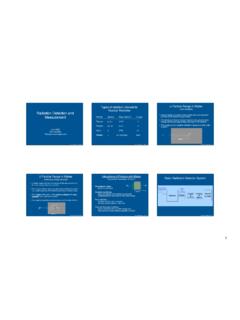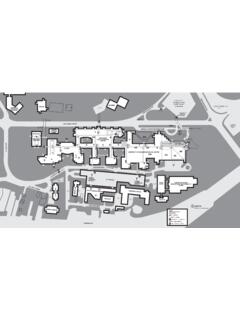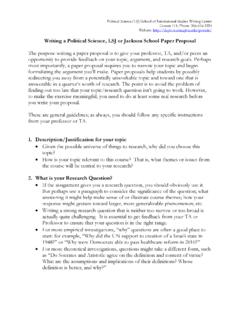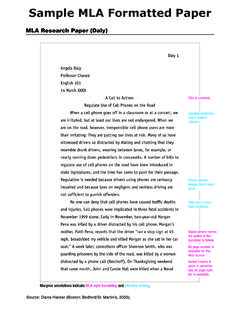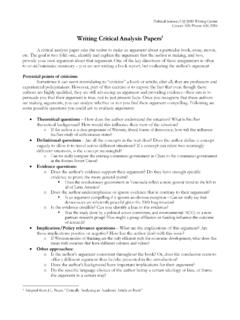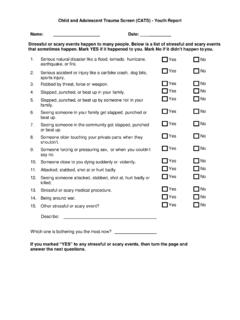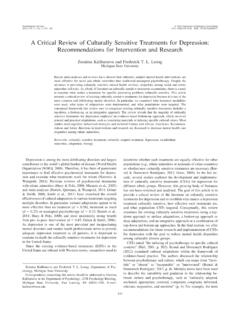Transcription of Applying Trauma-Focused Cognitive Behavioral Therapy …
1 ReviewApplying trauma -FocusedCognitive Behavioral Therapyin Group FormatEsther Deblinger1, Elisabeth Pollio1, and Shannon Dorsey2 AbstractTrauma- focused Cognitive Behavioral Therapy (TF-CBT), a well-established, evidence-based treatment for children who haveexperienced trauma , has been increasingly utilized in a group format. Group Therapy formats are appealing because they canbe highly effective and have the potential to reach larger numbers of clients. Moreover, TF-CBT group delivery may beparticularly valuable in reducing the feelings of shame, isolation, and stigma experienced by youth and their caregivers in theaftermath of traumatic experiences. This article reviews the group TF-CBT research, discusses the therapeutic benefits ofTF-CBT Therapy groups, and provides clinical and logistical guidance for implementing TF-CBT in group format, including asession-by-session protocol.
2 Future directions for research and clinical work in this area are also , child PTSD/ trauma , child trauma , intervention, caregiversTrauma- focused Cognitive Behavioral Therapy (TF-CBT) wasdesigned to help children, adolescents, and their familiesrecover from the negative effects of traumatic treatments designed for this purpose, several reviewsof the literature suggest that TF-CBT has the strongest empiri-cal support for treating this population with 16 randomizedcontrolled trials (RCTs) completed to date (de Arellano et al.,2014; Dorsey, Briggs, & Woods, 2011; Saunders, Berliner, &Hanson, 2004; Silverman et al., 2008). The efficacy ofTF-CBT was originally evaluated by testing an individuallydelivered treatment for children with a history of sexual abuse(Cohen, Deblinger, Mannarino, & Steer, 2004; Cohen & Man-narino, 1996, 1998; Cohen, Mannarino, Perel, & Staron, 2007;Deblinger, Lippmann, & Steer, 1996; Deblinger, Mannarino,Cohen, Runyon, & Steer, 2011; King et al.)
3 , 2000). More recentstudies replicated the effectiveness of individual TF-CBT withchildren exposed to domestic violence, children impacted bynatural disasters, and children placed in foster care as well asyoungsters impacted by multiple, diverse traumas in the UnitedStates ( ) and internationally (Cohen, Mannarino, & Iyen-gar, 2011; Diehl, Opmeer, Boer, Mannarino, & Lindauer,2015; Dorsey et al., 2014; Jaycox et al., 2010; Jensen et al.,2014; Murray et al., 2015). Three randomized trials also haveexamined the efficacy of TF-CBT delivered in group format(Deblinger, Stauffer, & Steer, 2001; McMullen, O Callaghan,Shannon, Black, & Eakin, 2013; O Callaghan, McMullen,Shannon, Rafferty, & Black, 2013). The purpose of this articleis to review the research on group TF-CBT, discuss the thera-peutic and cost benefits of TF-CBT delivered in groups, andprovide clinical and logistical guidance for implementingTF-CBT in group format, including a sample session-by-session protocol.
4 An additional session-by-session protocol isavailable in the Online Supplemental Table 2. This is the firstarticle to date to include this focus on clinical guidance for groupdelivery, which supplements the already available individualTF-CBT training manuals and free of charge website training(Cohen, Mannarino, & Deblinger, 2006, 2012; Deblinger, Man-narino, Cohen, Runyon, & Heflin, 2015; ).Directions for future clinical research with regard to group TF-CBT are also recent years, there has been growing interest in the efficacyand implementation of TF-CBT groups. This may be due to theincreasing demand for TF mental health services and the poten-tially greater cost-effectiveness of group Therapy approaches ingeneral. To date, research has not specifically examined differ-ences in clinical outcomes or cost-effectiveness for group versusindividual TF-CBT.
5 However, one study examining a similarCBT for child trauma (Salloum & Overstreet, 2008) and severalstudies comparing group versus individual CBT approaches for1 CARES Institute, Rowan University School of Osteopathic Medicine, Strat-ford, NJ, USA2 Department of Psychology, University of Washington, Seattle, WA, USAC orresponding Author:Esther Deblinger, CARES Institute, Rowan University School of OsteopathicMedicine, Stratford, NJ, : Maltreatment2016, Vol. 21(1) 59-73 The Author(s) 2015 Reprints and : anxiety have found no significant differences in clinicaloutcomes for delivery modality (Liber et al., 2008; Manassiset al., 2002). These findings suggest that group versus individualTF-CBT delivery modes may not differentially impact outcomes,with decisions about delivery mode potentially best determinedby pragmatic issues ( , wait lists and cost) and/or client prefer-ences.
6 In the area of cost-effectiveness, findings from a recentquasi-experimentalstudy found that TF-CBTdelivered individu-ally was considerably more cost-effective in the long term ascompared to treatment as usual (Greer, Grasso, Cohen, & Webb,2014), and that trauma -specific CBTs had high benefit-to-costratios (Washington State Institute for Public Policy, 2014).Although untested, we believe that group delivery of TF-CBTis similarlymorecost-effectivethantreatment as usual and poten-tially a more cost-effective strategy than individual delivery ofTF-CBT due to reduced total therapist hours per TF-CBT ResearchEvidence for TF-CBT group delivery comes from two studies inthe United States with young children who experienced sexualabuse (one open trial and one RCT), two RCTs in the Demo-cratic Republic of Congo (DRC) with war-affected adolescents,and an open trial in Tanzania with orphaned children (O Donnellet al.)
7 , 2014). The two studies focused on children 10 years with a history of sexual abuse and their nonoffend-ing mothers and include an open trial (Stauffer & Deblinger,1996) and an RCT (Deblinger et al., 2001). The RCT documen-ted the superior efficacy of TF-CBT groups as compared to sup-port groups in helping mothers overcome abuse-related distressand intrusive thoughts, while also documenting that young chil-dren assigned to the TF-CBT groups showed significantlygreater improvement with respect to body safety knowledge andskills than those children assigned to educational support improvements were maintained at a 3-month study, however, did not demonstrate significant differencesacross conditions on post-traumatic stress disorder (PTSD)symptoms, most likely because trauma narration in the TF-CBT groups was minimized due to the group format and the veryyoung age of the children.
8 Thus, as described below, TF-CBTgroups currently incorporate trauma narrative individual ses-sions midway through the group substantial proportion of the evidence for TF-CBT groupeffectiveness comes from two small RCTs in the DRC and anopen trial in Tanzania. The decision to use the group format forthese trials in low-income African countries reflects both thepossibility for greater reach and a potentially more culturallysyntonic option for treatment delivery, given the collectivist cul-tures. There are some differences in implementation of TF-CBTin low-income countries, primarily that treatment is delivered bylay counselors individuals with little to no prior mental healthtraining due to the shortage of mental health professionals. Laycounselors receive more intensive training ( , 2 weeks), closesupervision, and are connected to local mental health profession-als and organizations that can provide clinical support.
9 Addition-ally, TF-CBT is provided with fidelity, but local stories, idioms,and cultural norms are acknowledged while teaching new first RCT in DRC, which focused on girls aged 13 17 yearswho had been exposed to multiple traumas including war-relatedtrauma and sexual exploitation (O Callaghan et al., 2013), com-pared a 15-session group-based, culturally modified version ofTF-CBT to a wait-list control condition. trauma narrative workwas conducted in two to four individual sessions. The TF-CBTgroup led to significantly greater reductions in posttraumaticstress symptoms (PTS) as well as other psychosocial difficul-ties among the girls. The second RCT, by the same researchgroup and using a similar TF-CBT group structure ( , 15group sessions and two to four individual trauma narrativesessions), focused on former child soldiers and other war-affected boys, also aged 13 17 years, with very similar results(McMullen et al.)
10 , 2013). Boys in the TF-CBT group had sig-nificant decreases in PTS and other psychosocial difficultieswhen compared with the wait list. Treatment gains were main-tained or improved at the 3-month follow-up in both study that examined the potential value of groupTF-CBT for multiply traumatized children was conducted inTanzania with children aged 7 13 years who experienced thedeath of one or both parents and were having symptoms of PTSand/or maladaptive grief (O Donnell et al., 2014). The pre postfindings of this open trial demonstrated significant reductionsin PTS, grief, depressive symptoms, and Behavioral problemsat the end of treatment, with gains maintained at a 3- and12-month follow-up. The approach included 12 group sessions(concurrent child and caregiver groups), the first eight of whichwere focused on the PRACTICE components of TF-CBT, withthe final four groups focused on grief-specific components (seeCohen et al.
